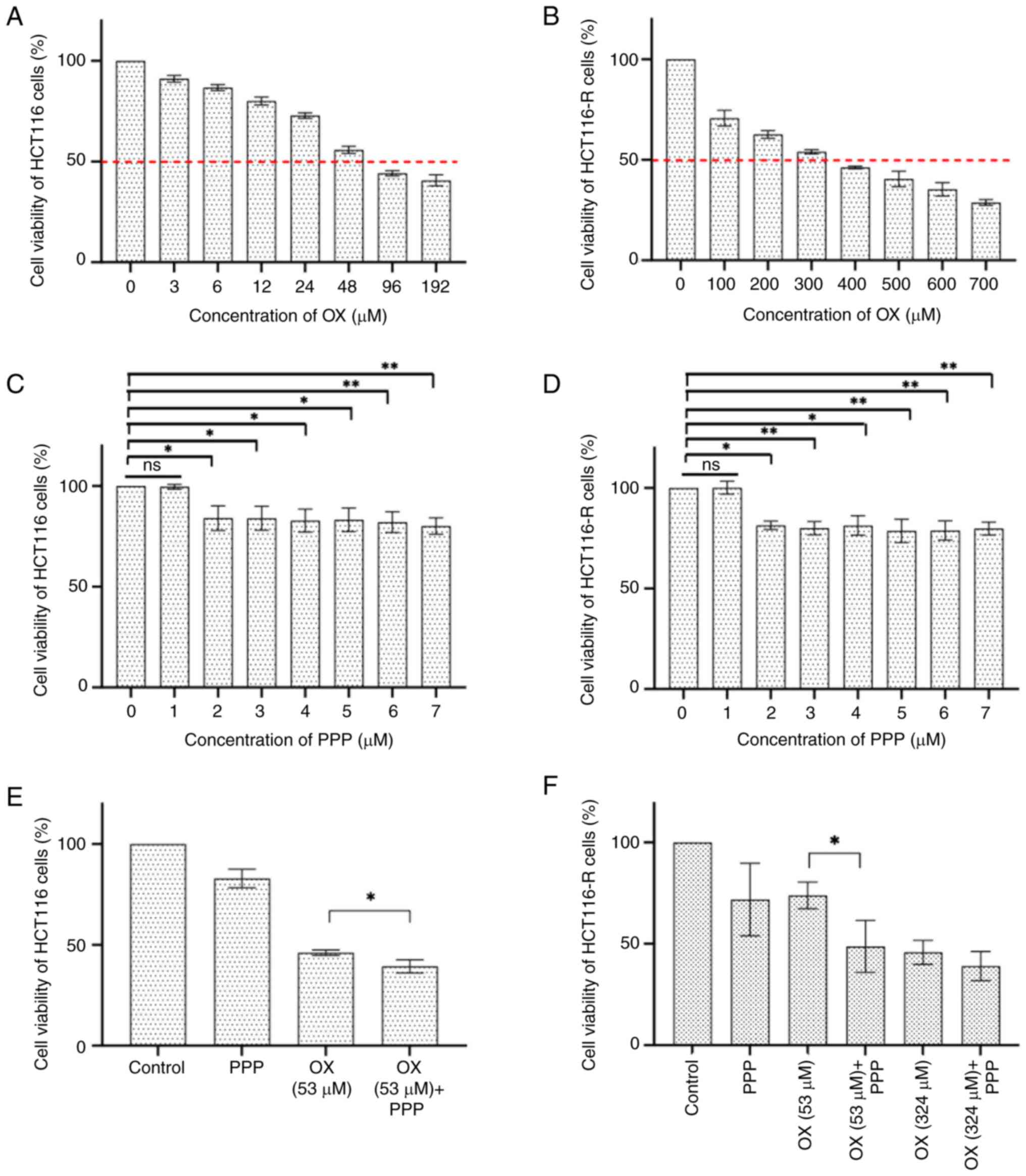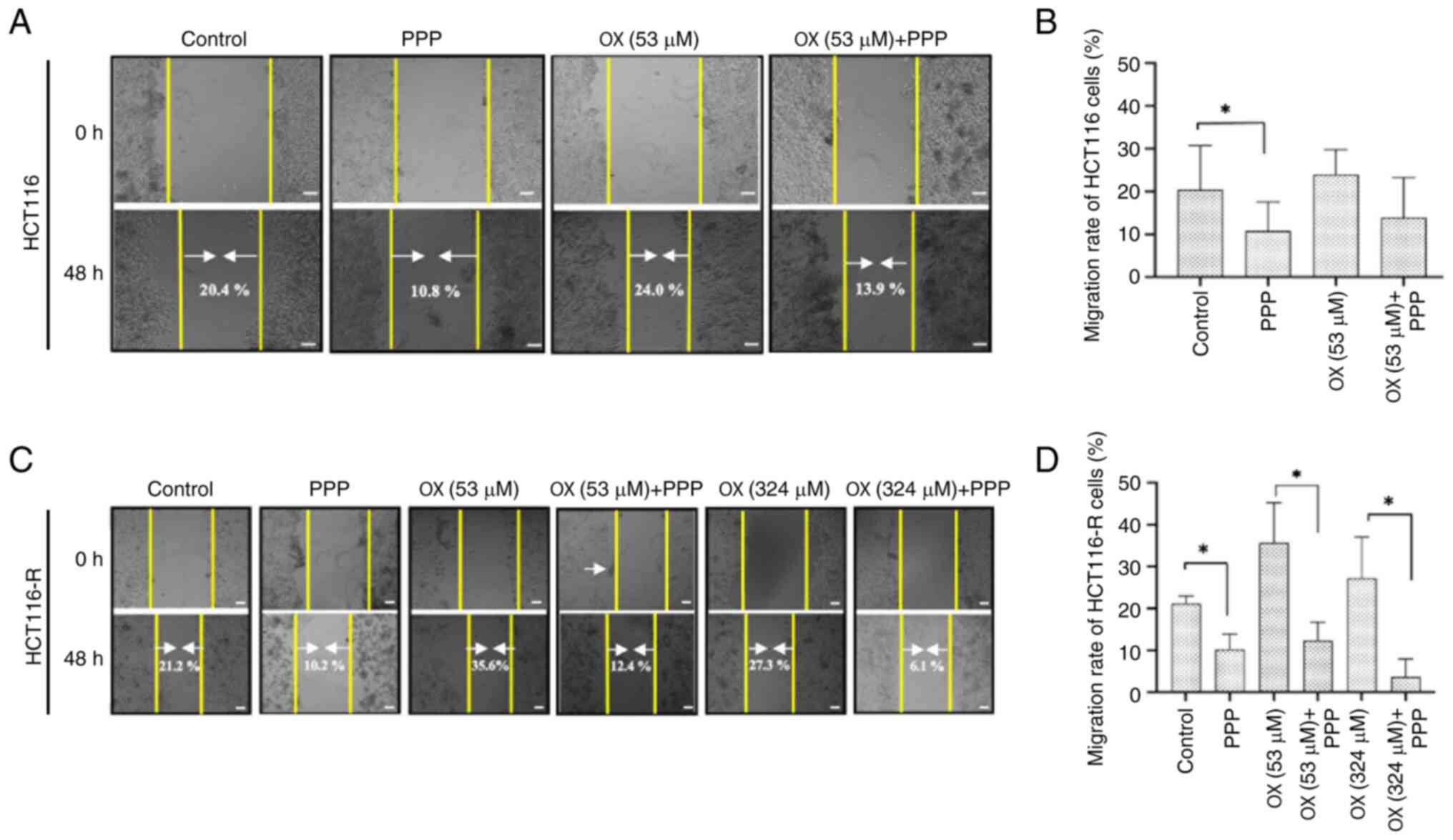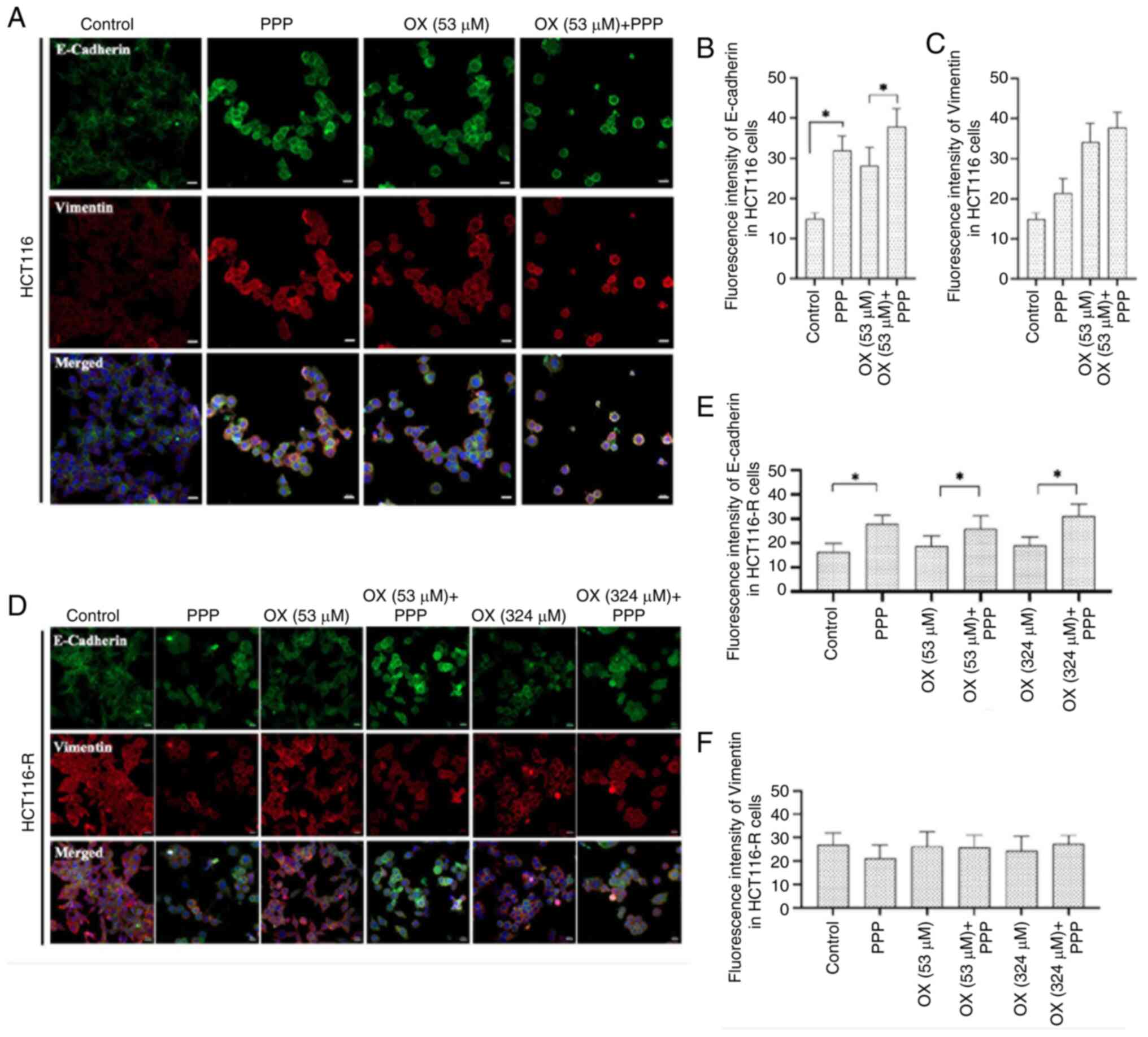|
1
|
Hammond WA, Swaika A and Mody K:
Pharmacologic resistance in colorectal cancer: A review. Ther Adv
Med Oncol. 8:57–84. 2016. View Article : Google Scholar : PubMed/NCBI
|
|
2
|
Biller LH and Schrag D: Diagnosis and
treatment of metastatic colorectal cancer: A review. JAMA.
325:669–685. 2021. View Article : Google Scholar : PubMed/NCBI
|
|
3
|
Li Y, Gan Y, Liu J, Li J, Zhou Z, Tian R,
Sun R, Liu J, Xiao Q, Li Y, et al: Downregulation of MEIS1 mediated
by ELFN1-AS1/EZH2/DNMT3a axis promotes tumorigenesis and
oxaliplatin resistance in colorectal cancer. Signal Transduct
Target Ther. 7:872022. View Article : Google Scholar : PubMed/NCBI
|
|
4
|
Jin Q, Feng J, Yan Y and Kuang Y:
Prognostic and immunological role of adaptor related protein
complex 3 subunit mu2 in colon cancer. Sci Rep. 14:4832024.
View Article : Google Scholar : PubMed/NCBI
|
|
5
|
Hashemi M, Esbati N, Rashidi M, Gholami S,
Raesi R, Bidoki SS, Goharrizi MASB, Motlagh YSM, Khorrami R,
Tavakolpournegari A, et al: Biological landscape and nanostructural
view in development and reversal of oxaliplatin resistance in
colorectal cancer. Transl Oncol. 40:1018462024. View Article : Google Scholar : PubMed/NCBI
|
|
6
|
Lu J, Kornmann M and Traub B: Role of
epithelial to mesenchymal transition in colorectal cancer. Int J
Mol Sci. 24:148152023. View Article : Google Scholar : PubMed/NCBI
|
|
7
|
Ho KH, Chen PH, Shih CM, Lee YT, Cheng CH,
Liu AJ, Lee CC and Chen KC: miR-4286 is involved in connections
between IGF-1 and TGF-β signaling for the mesenchymal transition
and invasion by glioblastomas. Cell Mol Neurobiol. 42:791–806.
2022. View Article : Google Scholar : PubMed/NCBI
|
|
8
|
Sabbah M, Emami S, Redeuilh G, Julien S,
Prévost G, Zimber A, Ouelaa R, Bracke M, De Wever O and Gespach C:
Molecular signature and therapeutic perspective of the
epithelial-to-mesenchymal transitions in epithelial cancers. Drug
Resist Updat. 11:123–151. 2008. View Article : Google Scholar : PubMed/NCBI
|
|
9
|
Ngo MT, Peng SW, Kuo YC, Lin CY, Wu MH,
Chuang CH, Kao CX, Jeng HY, Lin GW, Ling TY, et al: A
yes-associated protein (YAP) and insulin-like growth factor 1
receptor (IGF-1R) signaling loop is involved in sorafenib
resistance in hepatocellular carcinoma. Cancers (Basel).
13:38122021. View Article : Google Scholar : PubMed/NCBI
|
|
10
|
Kurter H, Basbinar Y, Ellidokuz H and
Calibasi-Kocal G: The Role of Cyanidin-3-O-glucoside in
modulating oxaliplatin resistance by reversing mesenchymal
phenotype in colorectal cancer. Nutrients. 15:47052023. View Article : Google Scholar : PubMed/NCBI
|
|
11
|
Hosseini SA, Zand H and Cheraghpour M: The
influence of curcumin on the downregulation of MYC, insulin and
IGF-1 receptors: A possible mechanism underlying the anti-growth
and anti-migration in chemoresistant colorectal cancer cells.
Medicina (Kaunas). 55:902019. View Article : Google Scholar : PubMed/NCBI
|
|
12
|
Feng X, Aleem E, Lin Y, Axelson M, Larsson
O and Strömberg T: Multiple antitumor effects of picropodophyllin
in colon carcinoma cell lines: Clinical implications. Int J Oncol.
40:1251–1258. 2012. View Article : Google Scholar : PubMed/NCBI
|
|
13
|
Pollak M: The insulin and insulin-like
growth factor receptor family in neoplasia: An update. Nat Rev
Cancer. 12:159–169. 2012. View
Article : Google Scholar : PubMed/NCBI
|
|
14
|
Nieto MA, Huang RY, Jackson RA and Thiery
JP: EMT: 2016. Cell. 166:21–45. 2016. View Article : Google Scholar : PubMed/NCBI
|
|
15
|
Ianza A, Sirico M, Bernocchi O and
Generali D: Role of the IGF-1 axis in overcoming resistance in
breast cancer. Front Cell Dev Biol. 9:6414492021. View Article : Google Scholar : PubMed/NCBI
|
|
16
|
Li H, Batth IS, Qu X, Xu L, Song N, Wang R
and Liu Y: IGF-IR signaling in epithelial to mesenchymal transition
and targeting IGF-IR therapy: Overview and new insights. Mol
Cancer. 16:62017. View Article : Google Scholar : PubMed/NCBI
|
|
17
|
Freier S, Weiss O, Eran M, Flyvbjerg A,
Dahan R, Nephesh I, Safra T, Shiloni E and Raz I: Expression of the
insulin-like growth factors and their receptors in adenocarcinoma
of the colon. Gut. 44:704–708. 1999. View Article : Google Scholar : PubMed/NCBI
|
|
18
|
Nosho K, Yamamoto H, Taniguchi H, Adachi
Y, Yoshida Y, Arimura Y, Endo T, Hinoda Y and Imai K: Interplay of
insulin-like growth factor-II, insulin-like growth factor-I,
insulin-like growth factor-I receptor, COX-2, and matrix
metalloproteinase-7, play key roles in the early stage of
colorectal carcinogenesis. Clin Cancer Res. 10:7950–7957. 2004.
View Article : Google Scholar : PubMed/NCBI
|
|
19
|
Yamamoto N, Oshima T, Yoshihara K, Aoyama
T, Hayashi T, Yamada T, Sato T, Shiozawa M, Yoshikawa T, Morinaga
S, et al: Clinicopathological significance and impact on outcomes
of the gene expression levels of IGF−1, IGF−2 and
IGF-1R, IGFBP−3 in patients with colorectal cancer:
Overexpression of the IGFBP−3 gene is an effective predictor
of outcomes in patients with colorectal cancer. Oncol Lett.
13:3958–3966. 2017. View Article : Google Scholar : PubMed/NCBI
|
|
20
|
Shiratsuchi I, Akagi Y, Kawahara A,
Kinugasa T, Romeo K, Yoshida T, Ryu Y, Gotanda Y, Kage M and
Shirouzu K: Expression of IGF-1 and IGF-1R and their relation to
clinicopathological factors in colorectal cancer. Anticancer Res.
31:2541–2545. 2011.PubMed/NCBI
|
|
21
|
Zhang Z, Zhang Y, Lao S, Qiu J, Pan Z and
Feng X: The clinicopathological and prognostic significances of
IGF-1R and Livin expression in patients with colorectal cancer. BMC
Cancer. 22:8552022. View Article : Google Scholar : PubMed/NCBI
|
|
22
|
Sekharam M, Zhao H, Sun M, Fang Q, Zhang
Q, Yuan Z, Dan HC, Boulware D, Cheng JQ and Coppola D: Insulin-like
growth factor 1 receptor enhances invasion and induces resistance
to apoptosis of colon cancer cells through the Akt/Bcl-x(L)
pathway. Cancer Res. 63:7708–7716. 2003.PubMed/NCBI
|
|
23
|
García-Echeverría C, Pearson MA, Marti A,
Meyer T, Mestan J, Zimmermann J, Gao J, Brueggen J, Capraro HG,
Cozens R, et al: In vivo antitumor activity of NVP-AEW541-A novel,
potent, and selective inhibitor of the IGF-IR kinase. Cancer Cell.
5:231–239. 2004. View Article : Google Scholar : PubMed/NCBI
|
|
24
|
Pennarun B, Kleibeuker JH, Oenema T,
Stegehuis JH, de Vries EG and de Jong S: Inhibition of
IGF-1R-dependent PI3K activation sensitizes colon cancer cells
specifically to DR5-mediated apoptosis but not to rhTRAIL. Anal
Cell Pathol (Amst). 33:229–244. 2010. View Article : Google Scholar : PubMed/NCBI
|
|
25
|
Pennarun B, Kleibeuker JH, Oenema T,
Stegehuis JH, de Vries EG and de Jong S: Inhibition of
IGF-1R-dependent PI3K activation sensitizes colon cancer cells
specifically to DR5-mediated apoptosis but not to rhTRAIL. Cell
Oncol (Dordr). 34:245–259. 2011. View Article : Google Scholar : PubMed/NCBI
|
|
26
|
Carboni JM, Wittman M, Yang Z, Lee F,
Greer A, Hurlburt W, Hillerman S, Cao C, Cantor GH, Dell-John J, et
al: BMS-754807, a small molecule inhibitor of insulin-like growth
factor-1R/IR. Mol Cancer Ther. 8:3341–3349. 2009. View Article : Google Scholar : PubMed/NCBI
|
|
27
|
Fuentes-Baile M, Ventero MP, Encinar JA,
García-Morales P, Poveda-Deltell M, Pérez-Valenciano E, Barberá VM,
Gallego-Plazas J, Rodríguez-Lescure Á, Martín-Nieto J and Saceda M:
Differential effects of IGF-1R small molecule tyrosine kinase
inhibitors BMS-754807 and OSI-906 on human cancer cell lines.
Cancers (Basel). 12:37172020. View Article : Google Scholar : PubMed/NCBI
|
|
28
|
Leiphrakpam PD, Agarwal E, Mathiesen M,
Haferbier KL, Brattain MG and Chowdhury S: In vivo analysis of
insulin-like growth factor type 1 receptor humanized monoclonal
antibody MK-0646 and small molecule kinase inhibitor OSI-906 in
colorectal cancer. Oncol Rep. 31:87–94. 2014. View Article : Google Scholar : PubMed/NCBI
|
|
29
|
Lee SO, Kwak AW, Lee MH, Seo JH, Cho SS,
Yoon G, Chae JI, Joo SH and Shim JH: Picropodophyllotoxin induces
G1 cell cycle arrest and apoptosis in human colorectal cancer cells
via ROS generation and activation of p38 MAPK signaling pathway. J
Microbiol Biotechnol. 31:1615–1623. 2021. View Article : Google Scholar : PubMed/NCBI
|
|
30
|
Sipos F, Bohusné Barta B, Simon Á, Nagy L,
Dankó T, Raffay RE, Petővári G, Zsiros V, Wichmann B, Sebestyén A
and Műzes G: Survival of HT29 cancer cells is affected by IGF1R
inhibition via modulation of Self-DNA-Triggered TLR9 signaling and
the autophagy response. Pathol Oncol Res. 28:16103222022.
View Article : Google Scholar : PubMed/NCBI
|
|
31
|
Codony-Servat J, Cuatrecasas M, Asensio E,
Montironi C, Martínez-Cardús A, Marín-Aguilera M, Horndler C,
Martínez-Balibrea E, Rubini M, Jares P, et al: Nuclear IGF-1R
predicts chemotherapy and targeted therapy resistance in metastatic
colorectal cancer. Br J Cancer. 117:1777–1786. 2017. View Article : Google Scholar : PubMed/NCBI
|
|
32
|
Sun R, Tanino R, Tong X, Haque EF, Amano
Y, Isobe T and Tsubata Y: Picropodophyllin inhibits the growth of
pemetrexed-resistant malignant pleural mesothelioma via microtubule
inhibition and IGF-1R-, caspase-independent pathways. Transl Lung
Cancer Res. 11:543–559. 2022. View Article : Google Scholar : PubMed/NCBI
|
|
33
|
Singh RK, Gaikwad SM, Jinager A, Chaudhury
S, Maheshwari A and Ray P: IGF-1R inhibition potentiates cytotoxic
effects of chemotherapeutic agents in early stages of
chemoresistant ovarian cancer cells. Cancer Lett. 354:254–262.
2014. View Article : Google Scholar : PubMed/NCBI
|
|
34
|
Du J, Shi HR, Ren F, Wang JL, Wu QH, Li X
and Zhang RT: Inhibition of the IGF signaling pathway reverses
cisplatin resistance in ovarian cancer cells. BMC Cancer.
17:8512017. View Article : Google Scholar : PubMed/NCBI
|
|
35
|
Präbst K, Engelhardt H, Ringgeler S and
Hübner H: Basic colorimetric proliferation assays: MTT, WST, and
Resazurin. Methods Mol Biol. 1601:1–17. 2017. View Article : Google Scholar : PubMed/NCBI
|
|
36
|
Ourhzif EM, Decombat C, Abrunhosa-Thomas
I, Delort L, Khouili M, Akssira M, Caldefie-Chezet F, Chalard P and
Troin Y: Synthesis and biological evaluation of new naphthoquinones
derivatives. Curr Org Synth. 17:224–229. 2020. View Article : Google Scholar : PubMed/NCBI
|
|
37
|
Liu T, Zhang X, Du L, Wang Y, Liu X, Tian
H, Wang L, Li P, Zhao Y, Duan W, et al: Exosome-transmitted
miR-128-3p increase chemosensitivity of oxaliplatin-resistant
colorectal cancer. Mol Cancer. 18:432019. View Article : Google Scholar : PubMed/NCBI
|
|
38
|
Boot A, van Eendenburg J, Crobach S, Ruano
D, Speetjens F, Calame J, Oosting J, Morreau H and van Wezel T:
Characterization of novel low passage primary and metastatic
colorectal cancer cell lines. Oncotarget. 7:14499–14509. 2016.
View Article : Google Scholar : PubMed/NCBI
|
|
39
|
McCarthy B, Singh R and Levi-Polyachenko
N: Oxaliplatin-resistant colorectal cancer models for nanoparticle
hyperthermia. Int J Hyperthermia. 38:152–164. 2021. View Article : Google Scholar : PubMed/NCBI
|
|
40
|
Tarnowski M, Tkacz M, Zgutka K, Bujak J,
Kopytko P and Pawlik A: Picropodophyllin (PPP) is a potent
rhabdomyosarcoma growth inhibitor both in vitro and in vivo. BMC
Cancer. 17:5322017. View Article : Google Scholar : PubMed/NCBI
|
|
41
|
Wang Q, Wei F, Lv G, Li C, Liu T,
Hadjipanayis CG, Zhang G, Hao C and Bellail AC: The association of
TP53 mutations with the resistance of colorectal carcinoma to the
insulin-like growth factor-1 receptor inhibitor picropodophyllin.
BMC Cancer. 13:5212013. View Article : Google Scholar : PubMed/NCBI
|
|
42
|
Dong L, Du M and Lv Q: Picropodophyllin
inhibits type I endometrial cancer cell proliferation via
disruption of the PI3K/Akt pathway. Acta Biochim Biophys Sin
(Shanghai). 51:753–760. 2019. View Article : Google Scholar : PubMed/NCBI
|
|
43
|
Kim SY, Toretsky JA, Scher D and Helman
LJ: The role of IGF-1R in pediatric malignancies. Oncologist.
14:83–91. 2009. View Article : Google Scholar : PubMed/NCBI
|
|
44
|
Oh SH, Jin Q, Kim ES, Khuri FR and Lee HY:
Insulin-like growth factor-I receptor signaling pathway induces
resistance to the apoptotic activities of SCH66336 (lonafarnib)
through Akt/mammalian target of rapamycin-mediated increases in
survivin expression. Clin Cancer Res. 14:1581–1589. 2008.
View Article : Google Scholar : PubMed/NCBI
|
|
45
|
Jones HE, Gee JM, Barrow D, Tonge D,
Holloway B and Nicholson RI: Inhibition of insulin receptor
isoform-A signalling restores sensitivity to gefitinib in
previously de novo resistant colon cancer cells. Br J Cancer.
95:172–180. 2006. View Article : Google Scholar : PubMed/NCBI
|
|
46
|
Li L, Gu X, Yue J, Zhao Q, Lv D, Chen H
and Xu L: Acquisition of EGFR TKI resistance and EMT phenotype is
linked with activation of IGF1R/NF-κB pathway in EGFR-mutant NSCLC.
Oncotarget. 8:92240–92253. 2017. View Article : Google Scholar : PubMed/NCBI
|
|
47
|
Cheng F, Zhang R, Sun C, Ran Q, Zhang C,
Shen C, Yao Z, Wang M, Song L and Peng C: Oxaliplatin-induced
peripheral neurotoxicity in colorectal cancer patients: Mechanisms,
pharmacokinetics and strategies. Front Pharmacol. 14:12314012023.
View Article : Google Scholar : PubMed/NCBI
|
|
48
|
Duan Z, Choy E, Harmon D, Yang C, Ryu K,
Schwab J, Mankin H and Hornicek FJ: Insulin-like growth factor-I
receptor tyrosine kinase inhibitor cyclolignan picropodophyllin
inhibits proliferation and induces apoptosis in multidrug resistant
osteosarcoma cell lines. Mol Cancer Ther. 8:2122–2130. 2009.
View Article : Google Scholar : PubMed/NCBI
|
|
49
|
Arcaro A: Targeting the insulin-like
growth factor-1 receptor in human cancer. Front Pharmacol.
4:302013. View Article : Google Scholar : PubMed/NCBI
|
|
50
|
Yang AD, Fan F, Camp ER, van Buren G, Liu
W, Somcio R, Gray MJ, Cheng H, Hoff PM and Ellis LM: Chronic
oxaliplatin resistance induces epithelial-to-mesenchymal transition
in colorectal cancer cell lines. Clin Cancer Res. 12((14 Pt 1)):
4147–4153. 2006. View Article : Google Scholar : PubMed/NCBI
|
|
51
|
Skarkova V, Kralova V, Krbal L, Matouskova
P, Soukup J and Rudolf E: Oxaliplatin and irinotecan induce
heterogenous changes in the EMT markers of metastasizing colorectal
carcinoma cells. Exp Cell Res. 369:295–303. 2018. View Article : Google Scholar : PubMed/NCBI
|
|
52
|
Li X, Zhang ZS, Zhang XH, Yang SN, Liu D,
Diao CR, Wang H and Zheng FP: Cyanidin inhibits EMT induced by
oxaliplatin via targeting the PDK1-PI3K/Akt signaling pathway. Food
Funct. 10:592–601. 2019. View Article : Google Scholar : PubMed/NCBI
|
|
53
|
Kurter H, Yesil J, Daskin E,
Calibasi-Kocal G, Ellidokuz H and Basbinar Y: Drug resistance
mechanisms on colorectal cancer. J Basic Clin Health Sci. 1:88–93.
2021. View Article : Google Scholar
|
|
54
|
Chen Y, Zheng X and Wu C: The role of the
tumor microenvironment and treatment strategies in colorectal
cancer. Front Immunol. 12:7926912021. View Article : Google Scholar : PubMed/NCBI
|













